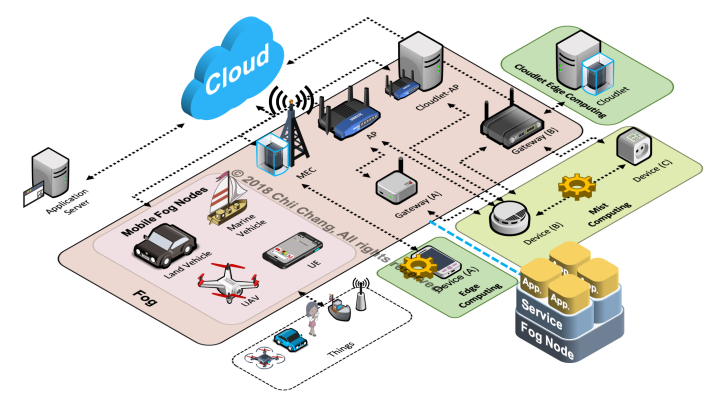Fog Computing, Edge Computing, are you confused?

The explanation of the terminologies:
- Fog computing architecture overcomes the BLURS (Bandwidth, Latency, Uninterrupted, Resource-constraint and Security) challenges of cloud-centric IoT systems.
- Fog computing is hierarchical and officially is a Top-down model.
- Fog nodes are the intermediate nodes (gateways) between the things and the cloud.
- A fog node is capable of providing five types of services: (1) acceleration; (2) cache/storage; (3) compute; (4) control; (5) networking.
- A fog node is at an Internet gateway. Classic fog nodes are at routers, switches, hubs (e.g. connect ZigBee to IP network), radio base stations, Wi-Fi Access Points (AP; at home/office/in-car/smartphone-enabled Wi-Fi hotspot) or other Internet gateways.
- A thing is an Internet-connectable object in the physical world.
- A thing (e.g. a car, a UAV, a UE) can also be the fog node (termed fog thing) of another thing as long as the fog thing has a gateway mechanism.
- The edge represents the connected things.
- The near-edge represents the fog nodes.
- A cloudlet is a computational resource at the edge or at the fog. It provides: (1) compute; (2) cache/storage. A machine can be a cloudlet without the Internet connection as long as it is accessible by the things in proximity.
- Offloading tasks from the things to cloudlets is called cloudlet edge computing.
- When a thing is handling task (e.g. processing data collected by itself) locally, it is called Edge Computing.
- If the process is handled among horizontally connected things or cloudlet, it is also called Edge Computing.
- Edge computing is a Bottom-up model.
- When a cloudlet is at the fog (as the gateway or co-located with the gateway in 0-hop range), it becomes a fog node, which can provide all the five services of the fog node.
- When two things can directly interact with one another to perform computational tasks and to make the decision without the assistance of the upper tiers (i.e. the fog and the cloud), it is called mist computing. Further, such things’ ad hoc network is called the mist.
- Multi-access Edge Computing (MEC), formerly known as Mobile Edge Computing, is a practical implementation of fog computing based on the network of the cellular Internet and ETSI standard. (see ETSI and OpenFog Consortium collaborate on fog and edge applications)
- Mobile Fog Node is a term used in the document of IEEE 1934 standard—OpenFog Reference Architecture for Fog Computing [OpenFog Consortium Architecture Working Group, 2017] to denote the fog node that is hosting on a moving object (e.g. a car).